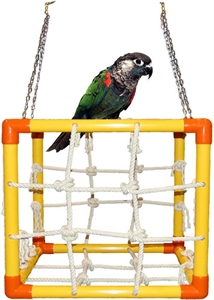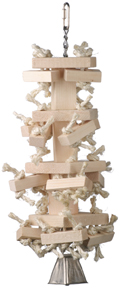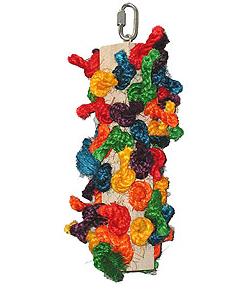Categories
- 10 Dollars and Under
- 5 Dollars and Under
- Avian Wear (Human and Feathered)
- Avitech
- AVIX Products
- Bees Wax Candles
- Bird Beds
- BIRDCARE Company Supplements
- Birdie Breads / Cookies
- Birdie Mashes
- Books / DVDs / Clickers
- Cage Accessories and Liners
- Cages
- Christmas Ideas
- Dishes, Bottles, Skewers
- Egg Food, Cuttle / Mineral
- Gift / Personal Items
- Gift Certificates
- Goldenfeast Gourmet Blends
- Hand Rearing / Nesting Supplies
- Harnesses / Travel Carriers
- Health / Wellness / Grooming
- Lighting / Lamps
- Lory Diets
- Molly's Bird Toys
- Nutritional
- Organic / Sprouters
- Parrot Greeting Cards
- Pellets
- Perches & Swings
- Perches FLAGSTONE
- Pest Control, Disinfectant Clean
- Pet Memorial
- Play Stands, Trees, Hanging Gym
- Poultry
- Ribbons &Bows, Doggies & Critter
- Seeds
- Snacks & Treats
- Toy Parts
- Toys
- Toys For the Feet
- Twin Beaks
- Window Decals
- Wingdow Seats
- Featured Products ...
- All Products ...
Manufacturers
Information
More Information
A Guide to the Selection of Safe Toys for your Bird(s)
A GUIDE TO THE SELECTION OF SAFE TOYS FOR YOUR BIRD
Most toy manufacturers do adhere to high standards in the production of their toys and choice of manufacturing materials but there are also lots of potentially dangerous toys on the market. This guide reviews the most prevalent materials currently used in bird toys and some design aspects you should consider when selecting a toy for your bird.
MATERIALS COMMONLY USED IN BIRD TOYS WOOD
Birds need to chew, wood is an excellent material to satisfy this natural urge. Birds play most often with wood toys. Wooden toys are meant to be destroyed. Some bird owners may be frustrated by the destructive nature of their parrots. However, chewing is a natural instinct and vital to birds mental and physical well-being. If you provide only acrylic toys they will often find other, more expensive ways to satisfy their chewing needs (i.e., molding, furniture). It is important to know what woods are safe for your bird. Both soft and hardwoods are commonly used in toys.
Safe Woods (not a complete list):
Pine, Balsa, Birch, Basswood, Poplar, Maple, Walnut, Ash, Apple, Elm, Cactus (Cholla) and Manzanita
Unsafe Woods (not a complete list):
Cedar, Red Cherry, Plywood. Oak
If you like to make your own toys NEVER use pressure treated wood, it is treated with arsenic and will poison your bird. If using natural branches make sure they have not been exposed to insecticides. Also, take care to collect branches in areas removed from highways where plant life may have absorbed toxic emissions from cars. Scrub all branches with a non-toxic disinfectant (dilute chlorine bleach), rinse and dry thoroughly.
If you need to clean wood toys, don't soak them. It is best to wipe them clean with a damp cloth or sand the soiled area until clean. If your bird likes to dunk his toys beware that moisture can promote bacterial growth and the toys should either be discarded or thoroughly cleaned and dried in a low temperature oven before returning them to the bird.
Birds are able to distinguish colors therefore color makes wood toys more attractive and interesting to birds. Manufacturers usually color wood with food coloring or vegetable dyes. We don't believe in flavoring wood as the bird should not be encouraged to ingest the wood and, unless properly controlled, the fruit sugars often used provide a perfect medium for bacterial growth. Do not buy toys that have been stained or varnished to add color. If you are interested in a toy with painted parts (ie, ABC blocks) make sure that only non-toxic, child safe paints were used.
ROPE
Several kinds of rope are used in bird toys. Only 100% natural fiber ropes such as cotton, hemp (jute), or sisal should be used in bird toys. Nylon blend ropes should never be used as they can result in serious injury and cuts due to the strength of the strands if the birds get caught in it. Ropes can be safe as long as they are maintained properly and the bird’s beak and nails are kept trim. There have been safety problems noted when excessive fraying occurs. Birds have choked and lost circulation to legs by getting tangled in ill maintained ropes. Rope toys have proven very beneficial in solving feather picking problems and therefore we don't like to discount rope as a viable material. Bird owners have a responsibility to check their bird's rope toys daily and to cut back or discard rope toys when they become frayed and present a hazard to their bird.
CHAIN
Chain should have welded not open links. Un-welded chain provides sharp surfaces and narrow openings which have been known to cut toes. Make sure the links are a safe size for your bird, if toes get caught in the links the result can be broken toes or legs. Chain length is also a consideration as a long length of chain could conceivably end up wrapped around a bird’s neck during a vigorous play session. As the wood components are chewed off, a chain hazard could develop. Owners must monitor the status of toys and ensure that as they physically change safety hazards do not develop.
FASTENERS
This is a crucial area of concern as good fasteners are expensive and therefore many manufacturers cut corners and use potentially unsafe items such as split key rings or dog leash type snap hooks. Birds have been cut and lost circulation to toes and tongues on toys utilizing split rings and spring type clamps. For conures or larger birds we recommend either Quick-links (also sometimes called C-clamps) or Pear links to attach toys to the bird's play area. They come in a variety of sizes and can be tightened with a wrench easily to prevent the bird from unhooking his toys. This type of fastener provides the least potential for injury. They are available in a variety of sizes and can be purchased from your local hardware store if needed to replace unsafe fasteners from existing toys.
Do not use split key rings, spring loaded clips or metal shower rings to fasten your toys. Small hardware pieces can be ingested accidentally. Birds have cut toes and tongues on split rings and spring type clamps.
ZINC
A lot has been mentioned recently about zinc toxicity in birds. Many bird toys are made with zinc coated (galvanized) metal components. Zinc is also commonly found in cage powder coatings. Some avian health specialists have stated that in order for zinc related health problems to result that the parrot must actually swallow the metal components and that “beaking” the parts is insufficient for toxicity to develop unless the galvanized coating is extremely brittle and flaky. If a bird spends a lot of time chewing on toy hardware (i.e., washers, quick links, wire) then it is possible they will ingest enough zinc to build up toxic levels in their systems over time. Owners who are worried about the possible health effects can often find stainless steel replacement components at their local hardware store. This option is also often much more cost effective to the consumer than buying toys constructed with stainless steel parts.
PLASTICS
Acrylics are used in many toys today and if sized properly to the bird are virtually indestructible. If purchasing acrylic toys we recommend the acrylic have a minimum thickness of 3/16". Recently, there has been a shift back towards wood toys because although the acrylics are durable and attractive they are also not as fun for the bird who likes to chew. We recommend that a few of your birds toys be acrylic or a blend of acrylic and wood, they will be long lasting and the bright colors used are stimulating to your bird.
When considering toys with plastic components a bird owner must consider the nature of the plastic component (i.e., soft vs. brittle) relative to the size of the bird. Brittle plastics should not be given to larger birds because when they break very sharp, cutting edges are formed and if swallowed accidentally could result in ruptured organs. Hard plastic toys specifically designed for parakeets and cockatiels should not be given to larger birds with the beak power to destroy them.
LEATHER
Leather is a great material for birds to safely play with and chew on. Most birds especially like to spend hours untying knots made in leather strips.
Only vegetable tanned leather should be used on bird toys. Do not buy toys with dyed leather or leather tanned with chemicals as most are toxic to birds (i.e., chromium, formaldehyde). For this reason you should also not retire old shoes, belts and pocketbooks to your birds toy chest.
Replace leather if soiled or wet. Bacteria will flourish under these conditions. Many toy companies will sell replacement leather strips.
When hanging toys strung on leather (or rope or chain), avoid leaving a long strand between the toy and the cage. Some birds when rambunctious with their toys can get the leather wrapped around their necks and strangle. It is best to tie the toy close to the bars of the cage.
RINGS
When choosing toys with rings or large plastic chain links make sure that the rings are of a size that the bird can’t get his head stuck in them and choke. Also beware of toys with multiple rings looped directly together as birds have met similar fates when they have been trapped between the rings.
BELLS
Birds love to make noise and bells provide a fun source for their merrymaking. If a bird is mechanically inclined and can remove the clapper the potential exists for swallowing/choking. Make sure the bell clapper can not be removed by the bird. If it is not securely fastened either remove it or weld it (we recommend silver solder). Make sure the clapper is not lead (toxic), if it is lead you will be able to dent the clapper with your fingernail. Do not buys toys that use jingle type bells, toes can become caught and cut in the wide to narrow openings, we recommend the cow or liberty bell design. Appropriately size the bell to the bird so it will be able to withstand the power of the beak.
FINAL CONSIDERATIONS
Just because the label says the product is safe doesn’t mean that it’s OK for your bird. Any toy has the potential to be unsafe if improperly sized to the bird. Ask your toy vendor or bird store owner for help or advice on choosing a toy appropriate for your bird.
As with kids, no toy is 100% safe for all birds. Use common sense and supervise your bird when you first give him a new toy. Observe how he interacts with the toy to determine how best to hang it and where and when to allow him to play with it (some toys are safer outside the cage).
Provide a wide variety of toys and rotate them in and out of the cage or play area. Variety will help alleviate boredom and keep your bird more alert and curious. Keep 2-3 toys minimum in the birds cage and don’t overstuff the cage so the bird doesn’t have room to move.
Don’t assume that if your bird doesn’t like a toy that it won’t play with any toy. Try something different and take the time to observe what your bird finds interesting in terms of design, texture or size.
Introduce toys to baby birds but make them small…don’t intimidate them. Hand toys are some of the safest toys available and they are especially great for young birds as they help to develop hand-eye coordination.
Play with your bird…most birds think it’s great fun to chase balls across the floor or couch, play “catch” or “pick it up” with mom or dad.
This guide is by no means comprehensive but we have tried to address as many issues as possible. When in doubt, ask for help. We sincerely wish you a long, happy and healthy relationship with your bird.
Important Links
- A Bit About Us
- A Guide to the Selection of Safe Toys for your Bird(s)
- Amino Acids
- Common Problems that can Happen with Baby Chicks
- Birdcare Simple System
- Fruits
- Giardia
- Goldenfeast Gourmet Blends Ingredients Listing
- Guardian Angel
- Minerals
- Nuts
- Substances Toxic to Our Birds
- The Basic Nutrients
- Toxic and Non Tox Plants Shrubs Trees
- US to Metric Conversions
- Vegetables
- Vitamins
- Volkmans Label Ingredients
- Flight Suit Sizing Chart




